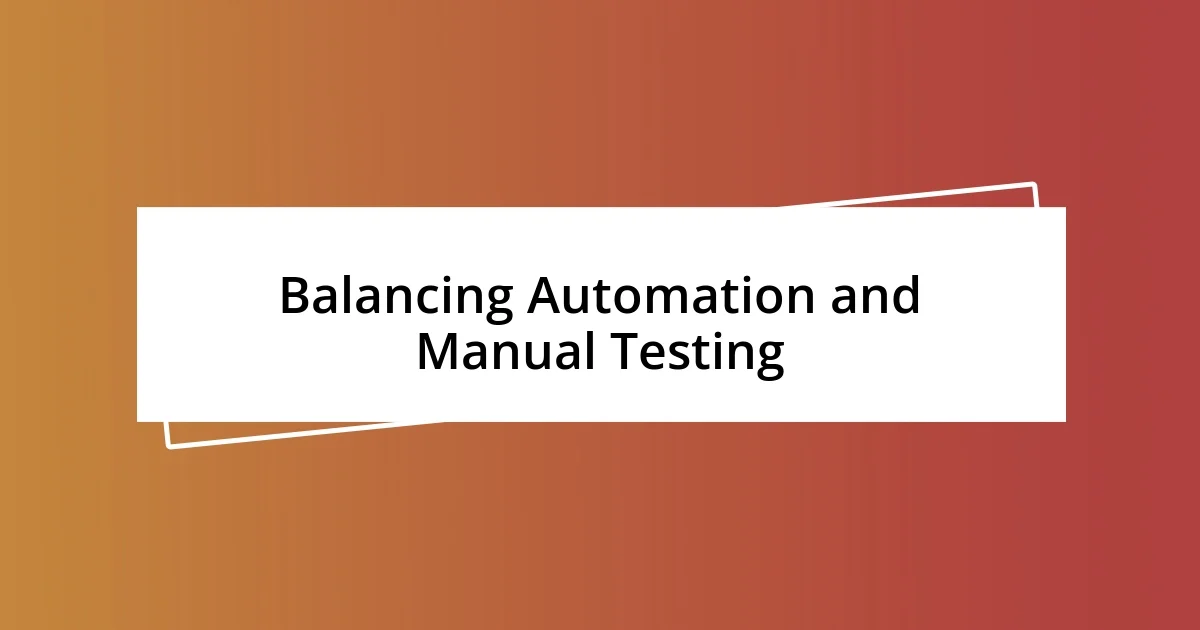Key takeaways:
- Automated testing enhances productivity and consistency, allowing for faster feedback loops and reduced human error during software development.
- Manual testing provides invaluable user experience insights, encourages creativity in problem-solving, and allows for quick adaptability to changing requirements.
- Balancing both automation and manual testing leads to a robust testing strategy, leveraging the strengths of each method to improve overall software quality.

Understanding Automated Testing Benefits
Automated testing brings undeniable benefits that can significantly enhance productivity and efficiency in software development. I once worked on a project where manual testing consumed countless hours, leading to burnout. Once we transitioned to automated tests, the time saved was substantial—it allowed the team to focus on innovative features rather than repetitive tasks. Have you ever felt overwhelmed by tedious testing processes? I certainly have, and automated testing can help alleviate that burden.
One of the most impressive advantages of automated testing is its ability to ensure consistency. In a previous role, we faced significant challenges due to human error in our manual tests, resulting in costly bugs slipping through. With automation, we established a reliable testing process that executed the same tests repeatedly, producing the same results every time. This reliability not only boosts our confidence in the software but also enhances the overall quality.
Additionally, automated testing enables faster feedback loops during development. I recall a scenario where automation allowed us to run tests with each code commit, leading to nearly immediate feedback. It was exhilarating to witness the swift identification of issues—my colleagues and I felt empowered. It made me wonder, how much more could we achieve if we could continuously integrate quality checks effortlessly? This kind of agility is something I truly appreciate about automated testing.

Evaluating Manual Testing Advantages
Manual testing still holds its ground, offering unique advantages that shouldn’t be overlooked. For instance, the intuitive understanding of user experience remains a strong suit of manual testing. I remember conducting manual tests for a mobile app where I could immediately feel how users would interact with different features. Nothing can replace that inspective touch—the nuances of user behavior can be complex, and that’s where manual testers excel.
One of my favorite aspects of manual testing is the creativity it encourages. I vividly recall a project where I explored edge cases that automated scripts simply would not have considered. It was a moment when I felt like a detective, piecing together the puzzle of user interactions. This space for investigation fosters a deeper understanding of the product and ultimately leads to a higher-quality end result.
Moreover, manual testing can adapt to new requirements swiftly. I once encountered a scenario where project specifications changed last minute. The onboarding of a quick, manual testing round enabled us to assess the new features effectively without the long wait times of setting up new automated tests. It’s moments like these that highlight the agility of manual testing—being able to pivot and react almost instantaneously can be a game-changer in the development cycle.
| Manual Testing Advantages | Details |
|---|---|
| User Experience Insight | Manual testers can tap into the nuances of user interactions, offering a more intuitive understanding of usability. |
| Creativity and Exploration | Encourages creative problem-solving and allows testers to consider edge cases that might be overlooked by automation. |
| Adaptability | Responds quickly to changes in requirements, allowing for immediate testing without setup delays. |

Comparing Automation and Manual Testing
When I reflect on the stark differences between automation and manual testing, it becomes clear that each has distinct strengths. Automation excels in repetitive tasks and consistent execution, allowing for quick response times following code changes. In contrast, manual testing thrives in understanding the user’s perspective, providing insights that automated scripts cannot capture. I remember a time when an automated test missed a critical UI issue that I noticed instantly during a manual check, highlighting the value of human intuition in testing.
Key Comparisons Between Automation and Manual Testing
- Speed vs. Insight: Automated testing can run tests at lightning speed, but manual testing shines in its ability to understand user context and nuance.
- Consistency vs. Creativity: Automation guarantees consistent results, whereas manual testing fosters creative exploration of edge cases and user behavior.
- Scalability vs. Flexibility: Automated tests can scale easily with the project, while manual testing provides the flexibility to pivot quickly in response to sudden requirement changes—like the time I had to adjust testing strategies on the fly for an unexpected feature release.
I truly value how both approaches bring something vital to the table. Each method has its own unique flavor, contributing to a well-rounded testing strategy. I often think about how integrating both can leverage the strengths of each, leading to a more robust final product.

When to Choose Automated Testing
When considering automated testing, I find it helpful to think about the project’s longevity and frequency of execution. If you’re working on a product with a lot of routine updates, automating those repetitive tests can save a massive amount of time. I remember a project where I automated regression tests for ongoing releases. It was liberating—no more manual retesting every time we patched a bug or made small adjustments. Have you ever experienced the relief of watching your tests run automatically while you focus on more creative aspects of your work?
Another crucial factor is the complexity of the application. For example, when I tested a web application with intricate functionalities, automated testing proved invaluable. It allowed us to run thorough multi-browser compatibility checks, something I would have found tedious to do manually. Automation became my ally in managing repetitive but essential tasks, freeing me up to explore deeper testing avenues.
Finally, think about the resource availability at your organization. If you have limited manual testing manpower, automation could be a game changer. I was once part of a small team that needed to deliver a comprehensive product quickly. By automating critical tests, we handled our work efficiently while ensuring quality. This balance between resource management and test coverage can make all the difference in delivering a successful software project.

Best Practices for Test Automation
When I think about best practices for test automation, the importance of choosing the right tools stands out to me. I’ve tried several testing frameworks over time, and I’ve learned that selecting one that fits the team’s skills and the project’s requirements is key. For instance, when I worked on a mobile app project, we opted for a framework that integrated seamlessly with our existing development environment. That decision streamlined our process, and I often wonder how much smoother things would have been if we hadn’t made a thoughtful choice in our tools.
Another essential practice is to maintain a clear and up-to-date test suite. I’ve experienced the frustration of running outdated tests that no longer reflect the current state of the application. It’s like trying to navigate a map that hasn’t been updated in years! Regularly reviewing and revising automated tests ensures they remain relevant and efficient. By doing this, we not only save time in the long run but also boost our team’s confidence in the test results.
Finally, I believe in the power of collaboration between developers and testers when implementing automation. When I worked hand-in-hand with developers during the automation phase, I found that we caught potential issues early and often. This collaboration creates a culture of shared responsibility for quality. It’s fascinating to see how a tiny tweak in a developer’s code can significantly impact our testing outcomes. Have you ever experienced that “aha!” moment while collaborating that shifted the project in a positive direction? I certainly have, and it’s those moments that remind me of the beauty of teamwork in achieving effective test automation.

Balancing Automation and Manual Testing
Balancing automation and manual testing is crucial for achieving optimal results. I’ve often found myself juggling between these two approaches, realizing that neither is a one-size-fits-all solution. There was a time when I leaned too much on automation, only to face the challenges of missing user-centric issues that were glaringly obvious during a manual exploration. Have you ever noticed that some of the best insights come from simply using the application like an end-user?
At one point in my career, I worked on a project where the blend of these testing methods drastically improved our output. We automated the critical paths to ensure quick iterations, while also setting aside specific times for manual testing to uncover nuanced bugs. This blend not only saved us time but also bolstered our confidence in releasing stable features. Balancing both methods allowed us to tap into the strengths of each—automation handling the repetitive tasks and manual testing focusing on user experience.
It’s about finding that sweet spot to ensure coverage without redundancy. I remember feeling overwhelmed by an extensive test suite that included many automated tests that no one maintained. It was a lightbulb moment when I realized that automation should enhance our manual efforts, not replace them. How do you strike that balance in your testing lifecycle? For me, the best strategy involves regular discussions with the team to align our testing goals and make informed decisions on when to switch gears between automation and manual testing.














